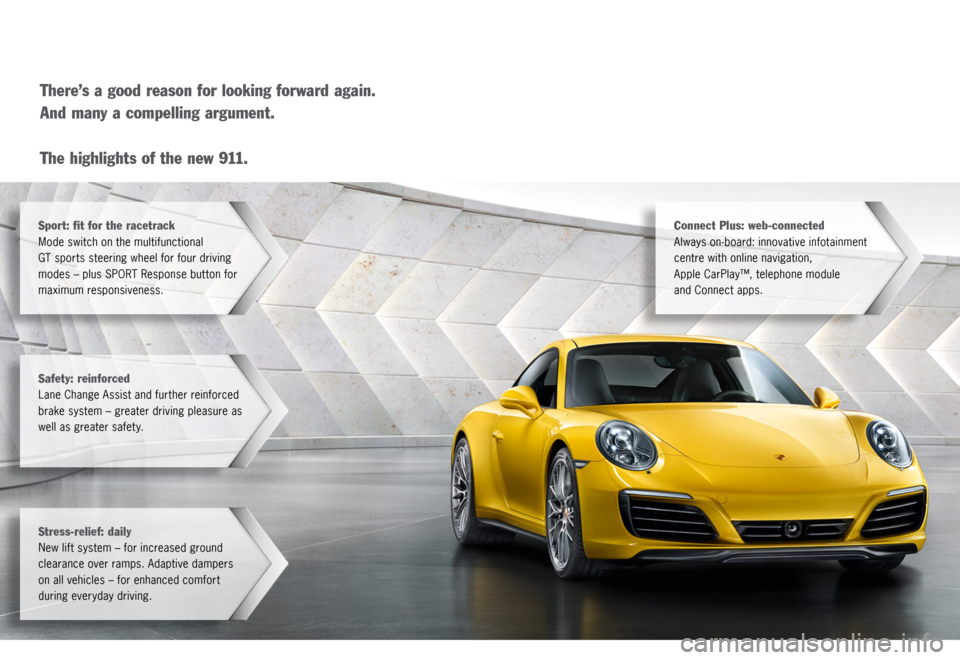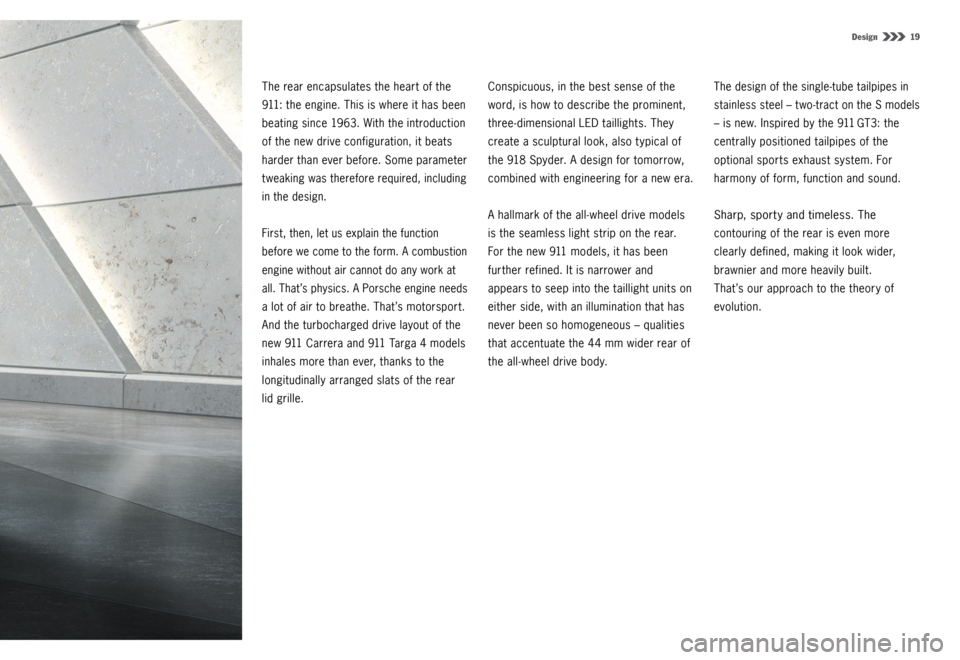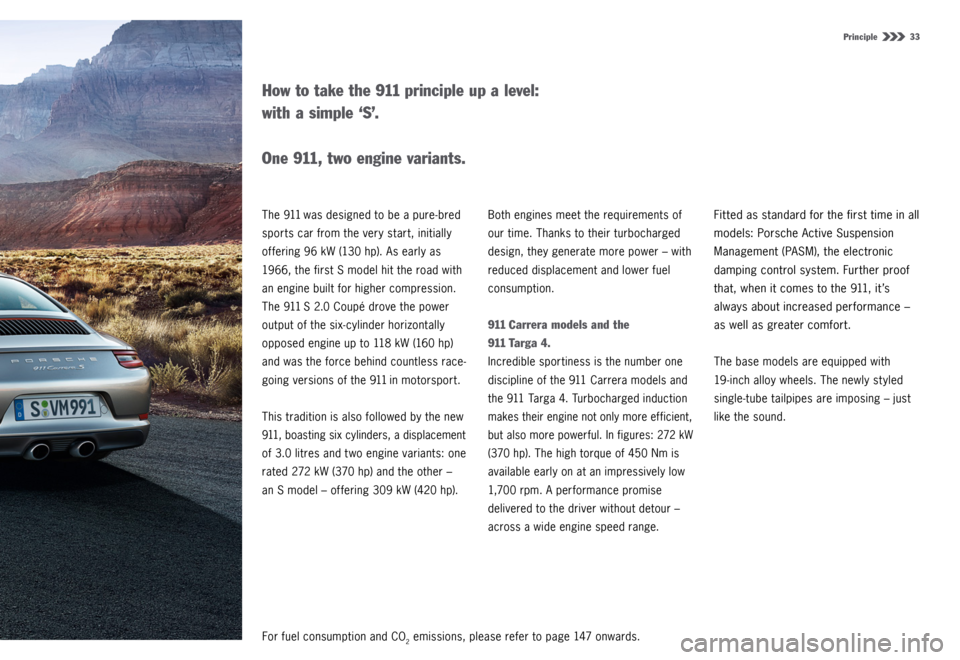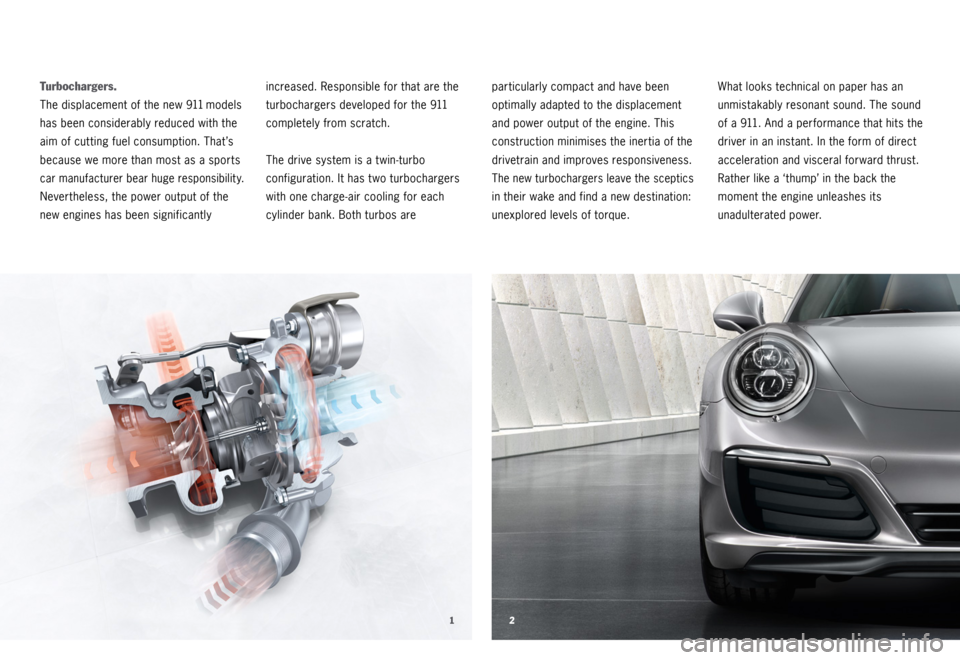sport mode PORSCHE 911 CARRERA 4S 2015 6.G Information Manual
[x] Cancel search | Manufacturer: PORSCHE, Model Year: 2015, Model line: 911 CARRERA 4S, Model: PORSCHE 911 CARRERA 4S 2015 6.GPages: 160, PDF Size: 33.25 MB
Page 12 of 160

Sport: fit for the racetrack
Mode switch on the multifunctional
GT sports steering wheel for four driving
modes – plus SPORT Response but ton for
maximum responsiveness.
Safety: reinforced
Lane Change Assist and further reinforced
brake system – greater driving pleasure as
well as greater safet y.
Stress-relief: daily
New lif t system – for increased ground
clearance over ramps. Adaptive dampers
on all vehicles – for enhanced comfort
during everyday driving.
Connect Plus: web-connected
Always on-board: innovative infotainment
centre with online navigation,
Apple CarPlay™, telephone module
and Connect apps.
There’s a good reason for looking forward again.
And many a compelling argument.
The highlights of the new 911.
Page 19 of 160

Design 19
The rear encapsulates the heart of the
911: the engine. This is where it has been
beating since 1963. With the introduction
of the new drive configuration, it beats
harder than ever before. Some parameter
tweaking was therefore required, including
in the design.
First, then, let us explain the function
before we come to the form. A combustion
engine without air cannot do any work at
all. That ’s physics. A Porsche engine needs
a lot of air to breathe. That ’s motorsport.
And the turbocharged drive layout of the
new 911 Carrera and 911 Targa 4 models
inhales more than ever, thanks to the
longitudinally arranged slats of the rear
lid grille.
Conspicuous, in the best sense of the
word, is how to describe the prominent,
three-dimensional LED taillights. They
create a sculptural look, also t ypical of
the 918 Spyder. A design for tomorrow,
combined with engineering for a new era.
A hallmark of the all-wheel drive models
is the seamless light strip on the rear.
For the new
911 models, it has been
further refined. It is narrower and
appears to seep into the taillight units on
either side, with an illumination that has
never been so homogeneous – qualities
that accentuate the 44 mm wider rear of
the all-wheel drive body.
The design of the single-tube tailpipes in
stainless steel – two-tract on the S models
–
is new. Inspired by the 911 GT3: the
centrally positioned tailpipes of the
optional sports exhaust system. For
harmony of form, function and sound.
Sharp, sport y and timeless. The
contouring of the rear is even more
clearly defined, making it look wider,
brawnier and more heavily built.
That ’s our approach to the theory of
evolution.
Page 21 of 160

Design 21
Design of the 911 Targa and
911
Cabriolet.
A legend of the 911 range, a classic, a
sports car dream – ‘the Targa’ always
will have a special place at Porsche.
Conceived 50 years ago as a ‘safet y
cabriolet’, the Targa gained its reputation
as a design icon thanks to its st yle-
defining roll bar. With the innovative fully
automatic roof system now in its seventh
generation, our engineers have seen the
Targa idea mature into a technical
masterpiece.
The roll bar, adorned with the ‘targa’ logo
underneath the side gills, and the
gracefully rounded rear screen bestow
the new 911
Targa 4 models with a
timeless elegance. Their engineering hallmark is the
inclusion of all-wheel drive as standard.
For added driving stability, reflected also
in the design, the body is 44 mm wider –
an impression accentuated by the
seamless light strip on the rear end.
Roof closed, the new 911
Targa displays
the profile of its 911
counterpart, whilst
offering the comfort of a Coupé. Open
the roof and the 911
Targa comes into its
own: a st yle icon that transcends fashions,
rich in tradition – even richer in future.
The new 911
Cabriolet models have also
always been characterised by open
virtues. Made for civilised cruising on
the coastal road, but also for some
sport y corner chasing in the mountains. Here, just like there, they excel with
powerful forward thrust, great agilit y,
and anticipation aplent y on every inch of
tarmac.
What does that have to do with design? A
great deal, because not only does the
innovative fabric hood capture the
elegance of a 911
Coupé silhouette, the
low drag coefficient and use of light weight
materials also mean that the 911 Cabriolet
models come uncannily close to matching
the performance of a closed-top 911.
Form and function once again working as
one. In a particularly aesthetic way.
Page 22 of 160

Roof system.
The fully automatic roof system of the
n e w 911
Targa 4 models is innovative –
and extremely robust. With the vehicle
stationary, the roof opens and closes
fully automatically in around 20 seconds.
And it folds away behind the rear seats
elegantly and with visual perfection. The roof materials are as pioneering as
the overall concept. Two magnesium
elements provide optimum tensioning of
the fabric hood, while the heatable rear
screen is made from laminated safet y
glass. Together with the soundproofed
interior lining of the hood itself, this
selection of materials ensures an
incredibly low level of driving noise with the roof closed. An extendable wind
deflector is integrated into the
windscreen cowl surround.
The roll-over protection of the Targa roll
bar fulfils the most stringent requirements
for safet y. And all the more so in terms
of design. It takes cues from the classic
form of the original Targa: with gills on either side, a surface finish in aluminium
and the ‘targa’ logo left and right.
In short, the roof system offers the driving
feel of a 911
Coupé and the driving
experience of an open-top sports car.
Page 25 of 160

Design 25
Interior design.
The interior of a Porsche is infused with
over 60 years of experience in sports
car construction. You can feel it: in the
materials, which are easy to grip and are
exquisitely made. You can see it: in the
sport y design. And it communicates
itself with every second of driving,
thanks to excellent ergonomics and
comfort.
Not an everyday sports car then, but a
sports car for everyday use. It’s clear the
moment you get in, and find an astonishing
amount of leg and head room. The new sports steering wheel speaks
the language of motorsport. The design
is based on the steering wheel of the
918 Spyder and combines st yle with
purism and a high level of functionalit y.
Integrated as standard in the 911
Carrera
a n d 911
Targa models for the first time:
Porsche Communication Management
(PCM) including online navigation module
with real-time traffic information, voice
control system and mobile phone
preparation as well as the Connect Plus
module.
Tradition meets innovation. The result?
Futurism, but of the Porsche kind.
Page 33 of 160

Principle 33
T h e 911 was designed to be a pure-bred
sports car from the very start, initially
offering 96 kW (130 hp). As early as
1966, the first S model hit the road with
an engine built for higher compression.
T h e 911
S 2.0 Coupé drove the power
output of the six-cylinder horizontally
opposed engine up to 118 kW (160 hp)
and was the force behind countless race-
going versions of the 911
in motorsport.
This tradition is also followed by the new
911, boasting six cylinders, a displacement
of 3.0 litres and t wo engine variants: one
rated 272 kW (370 hp) and the other –
an S model – offering 309 kW (420 hp). Both engines meet the requirements of
our time. Thanks to their turbocharged
design, they generate more power – with
reduced displacement and lower fuel
consumption.
911 Carrera models and the
911
Ta r g a 4.
Incredible sportiness is the number one
discipline of the 911 Carrera models and
the 911 Targa 4. Turbocharged induction
makes their engine not only more efficient,
but also more powerful. In figures: 272 kW
(370 hp). The high torque of 450 Nm is
available early on at an impressively low
1,700 rpm. A performance promise
delivered to the driver without detour –
across a wide engine speed range.
Fit ted as standard for the first time in all
models: Porsche Active Suspension
Management (PASM), the electronic
damping control system. Further proof
that, when it comes to the 911, it ’s
always about increased performance –
as well as greater comfort.
The base models are equipped with
19-inch alloy wheels. The newly styled
single-tube tailpipes are imposing – just
like the sound.
How to take the 911 principle up a level:
with a simple ‘S’.
One 911, two engine variants.
For fuel consumption and CO2 emissions, please refer to page 147 onwards.
Page 35 of 160

Principle 35
911 Carrera S models and the
911 Ta r g a 4 S.
The new S models raise the performance
concept to an even higher level, with a
t win-turbo engine capable of 309 kW
(420 hp). Here, too, a reduction in engine
capacit y and turbocharging has reduced
fuel consumption and increased driving pleasure at the same time. The S models
generate a maximum torque of 500 Nm –
from as low as 1,700 rpm – putting them
ahead of their predecessor once more by
an impressive 60 Nm. Putting you ahead
of the field.
T h e 911 Carrera S models and the
911 Targa 4S are equipped with 20 -inch alloy wheels. Traction is enhanced
by Porsche Torque Vectoring (PT V),
which is fit ted as standard. Porsche
Active Suspension Management (PASM),
the electronic damping control system,
also comes as standard. The new rear-
axle steering and Porsche Dynamic
Chassis Control (PDCC) are available on
request. Increased performance could not be
managed without greater safety.
The S models are therefore equipped
with six-piston aluminium monobloc fixed
brake calipers in red at the front and
four-piston equivalents at the rear.
Another hallmark of the new S models:
twin tailpipes in brushed stainless steel.
Well, ‘S’ does stand for Sport, doesn’t it?
For fuel consumption and CO
2 emissions, please refer to page 147 onwards.
Selected key features of the standard specification:
911
Carrera models and the 911 Ta r g a 4
– Six-cylinder twin-turbo boxer engine producing 272 kW (370 hp)
and 450 Nm
– 19-inch Carrera wheels
– Four-piston aluminium monobloc fixed brake calipers in black
front and rear
– Brake discs with 330-mm diameter front and rear
– Twin single-tube tailpipes in brushed stainless steel
– Porsche Active Suspension Management (PASM)
– SPORT button
– Porsche Communication Management (PCM) including online
navigation module with real-time traffic information
– Connect Plus Selected key features of the standard specification:
911
Carrera S models and the 911 Ta r g a 4 S
– Six-cylinder twin-turbo boxer engine producing 309 kW (420 hp)
and 500 Nm
– 20-inch Carrera S wheels
– Six-piston aluminium monobloc fixed brake calipers in red at front
and four-piston units at rear
– Brake discs with 350-mm diameter at front and 330-mm diameter at rear
– Twin dual-tube tailpipes in brushed stainless steel
– Porsche Torque Vectoring (PTV) or Porsche Torque Vectoring Plus
(PTV Plus)
– Porsche Active Suspension Management (PASM)
– SPORT button
– Porsche Communication Management (PCM) including online
navigation module with real-time traffic information
– Connect Plus
Page 37 of 160

Principle 37
F o r 911 fans it ’s a question of faith, for
tech lovers it ’s an issue of performance:
rear or all-wheel drive?
The answer may turn out differently on
either side, but neither would be wrong.
Those who recognise the rear-driven
variant as being the one true 911
should
consider that the all-wheel drive setup
goes back to the legendary Paris–Dakar
Rally of 1984, when the Porsche 953
based on the 911
wrote its own chapter
in sport – and engineering – history. Fun
in the corners, by the way, is guaranteed
by both drive layouts. Two irreconcilable philosophies? Let’s
discuss a third: the design. The all-wheel
drive 911
models have a 44 mm wider
body, let ting it rest more firmly on the
road. An impression underlined by the
new light strip, especially after dark.
Another hallmark of the all-wheel drive
models: sheer supremacy. In every
corner and at any time of year. Porsche
Traction Management (PTM), the active
all-wheel drive system, varies the drive
force transmit ted to all four wheels as
the situation demands. This helps to
ensure solid roadholding and even bet ter performance. Simultaneously, of course.
In winter. Day in, day out. At the limits of
dynamic driving performance.
Fair-weather cars? The new 911
Ta r g a 4
models are any thing but. Here, the all-
wheel drive marries excellent traction
with excellent aesthetics.
Rear or all-wheel drive? Whatever stance
you take, the most fascinating philosophy
of life is and shall remain the practical
one. At Porsche, this philosophy has been
about the road for well over 60 years.
Even philosophical questions
can be answered with outstanding performance.
Rear-wheel and all-wheel drive.
Page 41 of 160

Drive 41
At Porsche, there are no conventions.
Forbidding free thought? That’s forbidden.
The only thing that mat ters is this
question: how can we become even
bet ter? Let ’s put it another way: can we
redefine the limits of engineering? Can
we reconcile apparent contradictions?
Yes, we can. With Intelligent Performance.
The new 911 answers questions about
the future of the sports car with a
quantum leap in performance. By
reducing fuel consumption, but not by
suppressing emotions. By following a
principle that has already changed
every thing once before: in 1974, with the
f i r s t 911
Tu r b o. Developed completely from scratch, the
six-cylinder twin-turbo engines of the
911
Carrera and Targa 4 models with a
displacement of 3.0 litres embrace this
principle and perfect it in a forward-
l
ooking way. To be more precise:
tremendous acceleration force even in the
low rpm range is supplemented by the
engine map of a 911 Carrera with the high
rev limits t ypical of a sports car. In other
words, high compression and a high engine
speed combined with good modulation of
power output and surprisingly low fuel
consumption, thanks to the reduced
overall displacement.
Expressed in figures, this means an extra
15 kW (20 hp) of power, an extra 60 Nm
of torque and engine speeds of up to
7,500 rpm. And a considerable reduction
in fuel consumption of up to 13 %. The engine of the 911
Carrera and
911
Targa 4 models develops 272 kW
(370 hp). The maximum torque of
450 Nm is available from as low as
1
,700 rpm. With Porsche Doppelkupplung
(
PDK), the 911 Carrera can accelerate
from 0 to 62 mph in only 4.4 seconds
and reach a top speed of 182 mph.
The propulsive potential of the engine in
the S models, featuring upsized
turbochargers and independent exhaust
system, is even more impressive. It
generates a power output of 309 kW
(420 hp) and the maximum torque is a
might y 500 Nm, available from as low as
1
,700 rpm. With Porsche Doppelkupplung
(PDK) and Launch Control, the
We could sit back in the slipstream of our own tradition.
Or prepare to overtake.
Engines.
911 Carrera S sprints to 62 mph in a
mere 3 .9 seconds. Top speed isn’t
reached until 190 mph.
What cannot be expressed in figures: the
legendary sound of a 911
six-cylinder
horizontally opposed engine. And the
experience is all the more intense for it.
For fuel consumption and CO
2 emissions, please refer to page 147 onwards.
Prepare to overtake.
Scan code or go to w w w.porsche.co.uk/911- engines and star t the video.
Page 44 of 160

12
Turbochargers.
The displacement of the new 911 models
has been considerably reduced with the
aim of cut ting fuel consumption. That ’s
because we more than most as a sports
car manufacturer bear huge responsibility.
Nevertheless, the power output of the
new engines has been significantly increased. Responsible for that are the
turbochargers developed for the 911
completely from scratch.
The drive system is a t win-turbo
configuration. It has two turbochargers
with one charge-air cooling for each
cylinder bank. Both turbos are particularly compact and have been
optimally adapted to the displacement
and power output of the engine. This
construction minimises the inertia of the
drivetrain and improves responsiveness.
The new turbochargers leave the sceptics
in their wake and find a new destination:
unexplored levels of torque. What looks technical on paper has an
unmistakably resonant sound. The sound
of a 911. And a performance that hits the
driver in an instant. In the form of direct
acceleration and visceral forward thrust.
Rather like a ‘ thump’ in the back the
moment the engine unleashes its
unadulterated power.